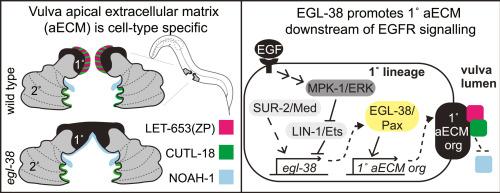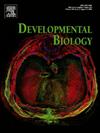Pax转录因子EGL-38将表皮生长因子受体信号传导与草履虫外阴部细胞类型特异性顶端细胞外基质的组装联系起来。
IF 2.5
3区 生物学
Q2 DEVELOPMENTAL BIOLOGY
引用次数: 0
摘要
上皮组织的表面由细胞外基质(apical extracellular matrix,aECM)覆盖。不同组织的细胞外基质具有不同的组成,以发挥不同的功能,但人们对特定细胞类型如何组装适当的细胞外基质还不甚了解。我们利用秀丽隐杆线虫外阴的细胞类型特异性基质来研究细胞特性与基质组装之间的联系。外阴是一个上皮管,由七种细胞类型组成,分别来自表皮生长因子受体/Ras依赖性(1˚)和Notch依赖性(2˚)系。外阴aECM含有多种透明带结构域(ZP)蛋白,它们是aECM的共同组成部分。ZP蛋白LET-653和CUTL-18聚集在1˚细胞表面,而NOAH-1则聚集在2˚细胞表面的一个子集上。所有三个 ZP 基因都是广泛转录的,这表明细胞类型特定的 ZP 组装必须由目的细胞表面的特征决定。配对盒(Pax)转录因子EGL-38能促进1˚基质的组装,防止2˚基质的不适当组装,这表明EGL-38能促进一个或多个ZP基质组织者的表达。我们的研究结果将已知的信号通路和各种下游效应因子与 EGL-38/Pax 的表达和外阴细胞命运执行的 ZP 基质成分联系起来。我们认为,专用的转录网络可能有助于许多上皮器官中细胞适当组装 aECM。本文章由计算机程序翻译,如有差异,请以英文原文为准。

The Pax transcription factor EGL-38 links EGFR signaling to assembly of a cell type-specific apical extracellular matrix in the Caenorhabditis elegans vulva
The surface of epithelial tissues is covered by an apical extracellular matrix (aECM). The aECMs of different tissues have distinct compositions to serve distinct functions, yet how a particular cell type assembles the proper aECM is not well understood. We used the cell type-specific matrix of the C. elegans vulva to investigate the connection between cell identity and matrix assembly. The vulva is an epithelial tube composed of seven cell types descending from EGFR/Ras-dependent (1°) and Notch-dependent (2°) lineages. Vulva aECM contains multiple Zona Pellucida domain (ZP) proteins, which are a common component of aECMs across life. ZP proteins LET-653 and CUTL-18 assemble on 1° cell surfaces, while NOAH-1 assembles on a subset of 2° surfaces. All three ZP genes are broadly transcribed, indicating that cell type-specific ZP assembly must be determined by features of the destination cell surface. The paired box (Pax) transcription factor EGL-38 promotes assembly of 1° matrix and prevents inappropriate assembly of 2° matrix, suggesting that EGL-38 promotes expression of one or more ZP matrix organizers. Our results connect the known signaling pathways and various downstream effectors to EGL-38/Pax expression and the ZP matrix component of vulva cell fate execution. We propose that dedicated transcriptional networks may contribute to cell-appropriate assembly of aECM in many epithelial organs.
求助全文
通过发布文献求助,成功后即可免费获取论文全文。
去求助
来源期刊

Developmental biology
生物-发育生物学
CiteScore
5.30
自引率
3.70%
发文量
182
审稿时长
1.5 months
期刊介绍:
Developmental Biology (DB) publishes original research on mechanisms of development, differentiation, and growth in animals and plants at the molecular, cellular, genetic and evolutionary levels. Areas of particular emphasis include transcriptional control mechanisms, embryonic patterning, cell-cell interactions, growth factors and signal transduction, and regulatory hierarchies in developing plants and animals.
 求助内容:
求助内容: 应助结果提醒方式:
应助结果提醒方式:


